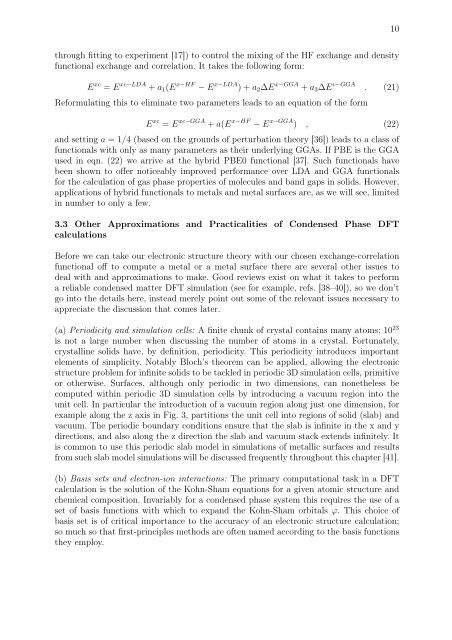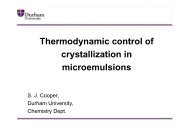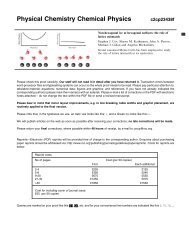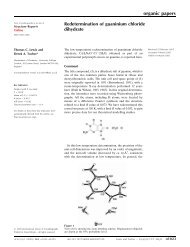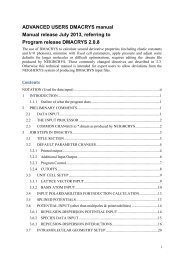An Introduction to the Theory of Crystalline Elemental Solids and ...
An Introduction to the Theory of Crystalline Elemental Solids and ...
An Introduction to the Theory of Crystalline Elemental Solids and ...
You also want an ePaper? Increase the reach of your titles
YUMPU automatically turns print PDFs into web optimized ePapers that Google loves.
10<br />
through fitting <strong>to</strong> experiment [17]) <strong>to</strong> control <strong>the</strong> mixing <strong>of</strong> <strong>the</strong> HF exchange <strong>and</strong> density<br />
functional exchange <strong>and</strong> correlation. It takes <strong>the</strong> following form:<br />
E xc = E xc−LDA + a 1 (E x−HF − E x−LDA ) + a 2 ∆E x−GGA + a 3 ∆E c−GGA . (21)<br />
Reformulating this <strong>to</strong> eliminate two parameters leads <strong>to</strong> an equation <strong>of</strong> <strong>the</strong> form<br />
E xc = E xc−GGA + a(E x−HF − E x−GGA ) , (22)<br />
<strong>and</strong> setting a = 1/4 (based on <strong>the</strong> grounds <strong>of</strong> perturbation <strong>the</strong>ory [36]) leads <strong>to</strong> a class <strong>of</strong><br />
functionals with only as many parameters as <strong>the</strong>ir underlying GGAs. If PBE is <strong>the</strong> GGA<br />
used in eqn. (22) we arrive at <strong>the</strong> hybrid PBE0 functional [37]. Such functionals have<br />
been shown <strong>to</strong> <strong>of</strong>fer noticeably improved performance over LDA <strong>and</strong> GGA functionals<br />
for <strong>the</strong> calculation <strong>of</strong> gas phase properties <strong>of</strong> molecules <strong>and</strong> b<strong>and</strong> gaps in solids. However,<br />
applications <strong>of</strong> hybrid functionals <strong>to</strong> metals <strong>and</strong> metal surfaces are, as we will see, limited<br />
in number <strong>to</strong> only a few.<br />
3.3 O<strong>the</strong>r Approximations <strong>and</strong> Practicalities <strong>of</strong> Condensed Phase DFT<br />
calculations<br />
Before we can take our electronic structure <strong>the</strong>ory with our chosen exchange-correlation<br />
functional <strong>of</strong>f <strong>to</strong> compute a metal or a metal surface <strong>the</strong>re are several o<strong>the</strong>r issues <strong>to</strong><br />
deal with <strong>and</strong> approximations <strong>to</strong> make. Good reviews exist on what it takes <strong>to</strong> perform<br />
a reliable condensed matter DFT simulation (see for example, refs. [38–40]), so we don’t<br />
go in<strong>to</strong> <strong>the</strong> details here, instead merely point out some <strong>of</strong> <strong>the</strong> relevant issues necessary <strong>to</strong><br />
appreciate <strong>the</strong> discussion that comes later.<br />
(a) Periodicity <strong>and</strong> simulation cells: A finite chunk <strong>of</strong> crystal contains many a<strong>to</strong>ms; 10 23<br />
is not a large number when discussing <strong>the</strong> number <strong>of</strong> a<strong>to</strong>ms in a crystal. Fortunately,<br />
crystalline solids have, by definition, periodicity. This periodicity introduces important<br />
elements <strong>of</strong> simplicity. Notably Bloch’s <strong>the</strong>orem can be applied, allowing <strong>the</strong> electronic<br />
structure problem for infinite solids <strong>to</strong> be tackled in periodic 3D simulation cells, primitive<br />
or o<strong>the</strong>rwise. Surfaces, although only periodic in two dimensions, can none<strong>the</strong>less be<br />
computed within periodic 3D simulation cells by introducing a vacuum region in<strong>to</strong> <strong>the</strong><br />
unit cell. In particular <strong>the</strong> introduction <strong>of</strong> a vacuum region along just one dimension, for<br />
example along <strong>the</strong> z axis in Fig. 3, partitions <strong>the</strong> unit cell in<strong>to</strong> regions <strong>of</strong> solid (slab) <strong>and</strong><br />
vacuum. The periodic boundary conditions ensure that <strong>the</strong> slab is infinite in <strong>the</strong> x <strong>and</strong> y<br />
directions, <strong>and</strong> also along <strong>the</strong> z direction <strong>the</strong> slab <strong>and</strong> vacuum stack extends infinitely. It<br />
is common <strong>to</strong> use this periodic slab model in simulations <strong>of</strong> metallic surfaces <strong>and</strong> results<br />
from such slab model simulations will be discussed frequently throughout this chapter [41].<br />
(b) Basis sets <strong>and</strong> electron-ion interactions: The primary computational task in a DFT<br />
calculation is <strong>the</strong> solution <strong>of</strong> <strong>the</strong> Kohn-Sham equations for a given a<strong>to</strong>mic structure <strong>and</strong><br />
chemical composition. Invariably for a condensed phase system this requires <strong>the</strong> use <strong>of</strong> a<br />
set <strong>of</strong> basis functions with which <strong>to</strong> exp<strong>and</strong> <strong>the</strong> Kohn-Sham orbitals ϕ. This choice <strong>of</strong><br />
basis set is <strong>of</strong> critical importance <strong>to</strong> <strong>the</strong> accuracy <strong>of</strong> an electronic structure calculation;<br />
so much so that first-principles methods are <strong>of</strong>ten named according <strong>to</strong> <strong>the</strong> basis functions<br />
<strong>the</strong>y employ.


